Renault Master Z.E/e-Tech (2018 – 2024) Review
Renault Master Z.E/e-Tech (2018 – 2024) At A Glance
The Renault Master ZE was something of a pioneer, with only it and the Mercedes e-Sprinter offering genuine large van capacity with all-electric power. But rivals have caught up and now it’s no longer an innovator, so does the big panel van still make sense? Read our full Renault Master e-Tech review to find out.
Originally called the Renault Master ZE and offered alongside the all-electric Renault Kangoo ZE, the model received a facelift in 2019 and was relaunched as the Renault Master e-Tech.
When new, it led the pack – no other manufacturer was brave enough to offer a fully electric large van (though Mercedes soon followed) and it needed a huge battery pack to be functional, adding substantial weight.
That battery is a 52kWh item, which isn’t as impressive as it once was in terms of capacity and gives the Renault Master e-Tech a range of 124 miles based on WLTP standards.
Critically, it also doesn’t support three-phase high-speed charging, which will limit the van’s appeal, though it’s still suitable for users who have the capacity to charge it overnight - around 10 hours on a domestic supply, or six with a single-phase AC wallbox with fast-charging capacity.
Where it does shine, though, is in its flexibility. There is an impressive choice of 15 different versions available including chassis cabs and multiple body lengths and roof heights, giving between eight and 15 cubic metres of load capacity and a payload of up to 1.2 tonnes - 450kg less than a diesel Renault Master.
The Renault Master e-Tech is set to be replaced in late 2024, meaning its appeal as a new vehicle is limited, but as a used electric van it holds a fair amount of appeal.
The Renault Master e-Tech is a van designed to fit a very specific brief and when considered on that basis alone, it acquits itself quite well.
But for most users, it represents a compromise and while Renault ought to be commended for leading the pack, it appears that others have now caught up, and quite a few have overtaken the French manufacturer. It will be interesting to see how it fights back when the new Renault Master e-Tech makes its debut.
Driving the Renault Master Z.E/e-Tech (2018 – 2024)
Much like the diesel Renault Master, the cabin of the electric model puts functionality first. It feels a tad dated, but there’s no faulting the layout with lots of storage options for paperwork, flasks, bags and other personal items.
The cab is pretty much the same as you’d expect in a diesel automatic model other than a battery level indicator and you select drive with a small lever to switch between forward, reverse, neutral and park. Infotainment is pretty simple but easy to operate via a seven-inch touchscreen. There are no bells or whistles, but the system will pair with your smartphone and induction charging is also a feature.
Overall, it’s a comfortable van without being fussy and the driving position is commanding with very good all-round visibility. For professional drivers, that’s very much the basics covered.
The electric motor offers a modest sounding 76PS, but it’s still reasonably quick off the mark and extremely refined. Head into open traffic and the power deficit compared with rivals becomes apparent – it can feel like a bit of slog to pilot down fast A-roads and dual carriageways, but that’s not the Renault Master e-Tech’s ideal environment to begin with. After all, the top speed is limited to 55mph.
It rides comfortably and feels sure-footed in terms of handling, so much as a large van can. It also has a lot of safety kit including Automatic Emergency Braking, Side-Wind Assist, Lane Departure Warning, Rear Parking Assistance and a reversing camera.
Renault Master Z.E/e-Tech (2018 – 2024) interior
Offered in short, medium and long wheelbase layouts, each version of the Renault Master e-Tech is impressive in terms of load space – even the shortest version feels vast and will swallow two Euro pallets with ease, but the heavy battery pack limits the payload to a maximum of 1,200kg.
The range of 124 miles will be adequate for most urban multi-drop operators but its appeal will be limited to those who venture outside the city limits thanks to the lack of high-speed charging ability at motorway service stations.
That said, there are few vans as capacious if you regularly need to move big loads while complying with emissions zones or avoiding the use of fossil fuels, so it still has appeal to certain types of user, who will thoroughly appreciate its ease of loading.
The load area isn't compromised by the electric motor or batteries either – all are flat under the floor – and even in its shortest form it offers a load bay length of 3083mm, rising to 3733mm in the longer model. There’s a wide-access single side-loading door on the passenger side, and 1780mm of load height in standard models.
There are also several Renault-approved conversions available, including dropside and tipper versions.
Model History
- March 2018: Renault Master Z.E unveiled
- November 2018: Renault Master Z.E priced from £45,700 excluding VAT
March 2018
Renault Master Z.E unveiled
Renault broadens its range of electric vans with the introduction of the Master Z.E. large electric van. Ideal for emissions-free access to city centres, Master Z.E. is well-suited to last-mile deliveries.
Master Z.E. uses lithium Ion 33kWh Z.E.33 battery and takes six hours to fully charge. Renault advertises the van with a 74-mile real-world range.
The four van line-up covers 8.0 to 13 cubic metres of load space and a payload of 1 to 1,1 tonnes. The load area is identical to that of the internal-combustion version, since the battery's optimised dimensions allow it to be fitted under the bodywork.
In addition, Master Z.E.'s load bed height is among the lowest in this segment (54–56cm) and the optional 270-degree door openings help with loading and unloading. The two platform cab versions feature 2 lengths (L2 and L3). Their payload of 1370 kg and 1350 kg are suitable for conversions in High-Capacity body for transport up to 19 cubic metres.
November 2018
Renault Master Z.E priced from £45,700 excluding VAT
Master Z.E. is available in a choice of three wheelbase configurations – SWB, MWB and LWB – with a choice of two roof heights, LR & MR.
All are based on the well-equipped Business specification that is available across the Renault Master range. Focused on providing drivers with high levels of comfort, convenience, connectivity and safety, standard features of the Business trim level include electric front windows and mirrors, DAB radio, Bluetooth, CD player, USB, full steel bulkhead, ESC, Hill Start Assist and Trailer Swing Assist.
Specific equipment that is unique to the New Master Z.E. includes a side charging socket, pre-heating function, and Z.E. voice – a specific sound that the vehicle makes at low speeds in order to be more noticeable to pedestrians.
Exclusive New Master Z.E. options include a charging cable suitable for a domestic three-pin plug and a three-year renewal subscription to My Z.E Connect, which when combined with the R-Link media system, lets you view the vehicle’s range on a smartphone or computer connected to the internet.

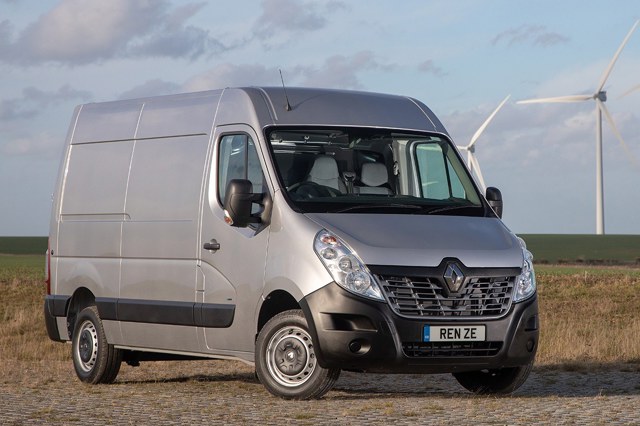
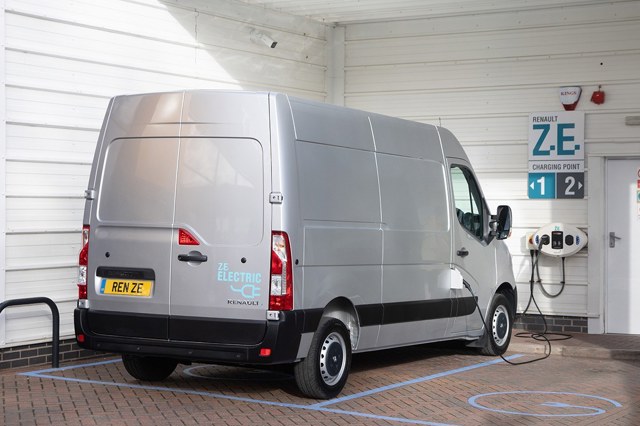
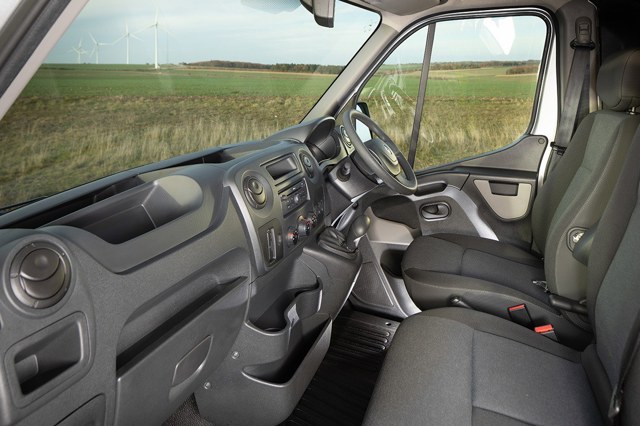
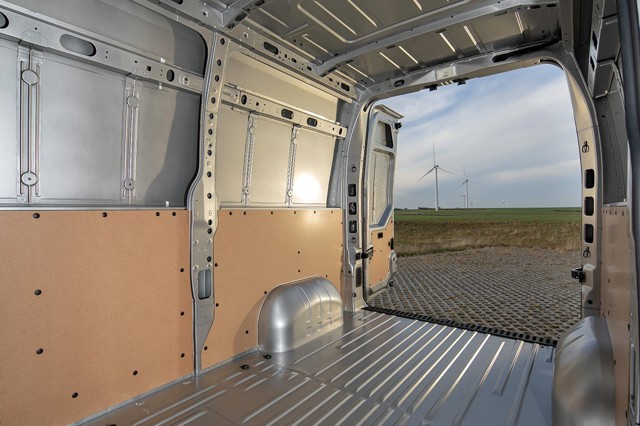
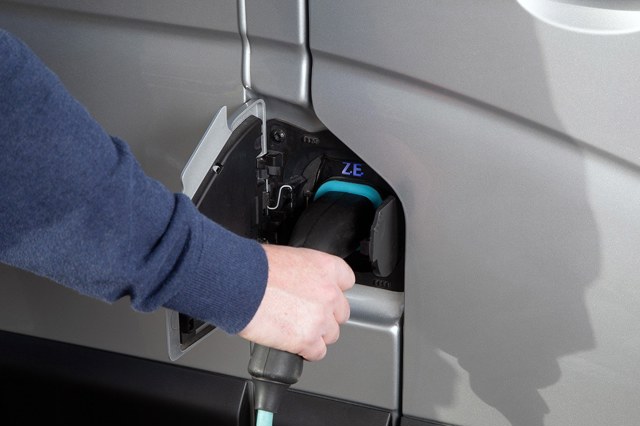
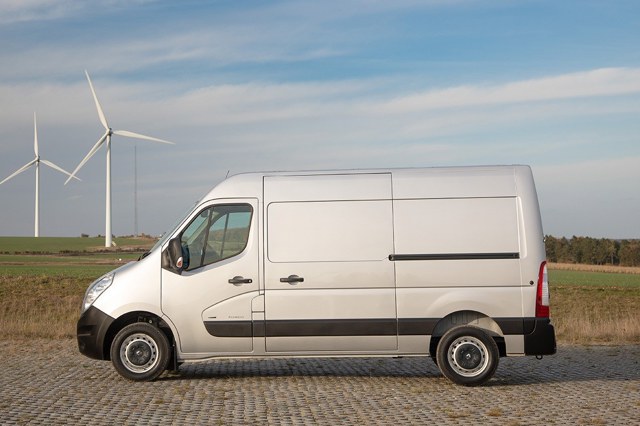

 Huge load area, decent payload, refined
Huge load area, decent payload, refined
 Limited range, feels outdated in some areas
Limited range, feels outdated in some areas


